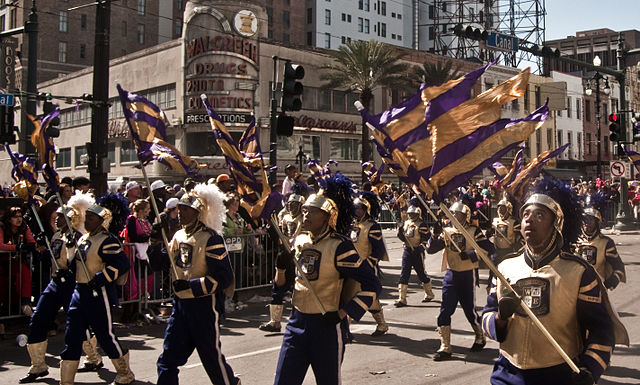
NEW ORLEANS—If you want to visit New Orleans for Mardi Gras and don’t have hotel reservations, you may need a tent. But you might not even be able to find tent space for the 10th Mardi Gras since Hurricane Katrina flooded the city.
Cheap gas and a holiday trifecta are contributing to strong lodging demands. Mardi Gras falls on Feb. 17, the day before is Presidents Day and the Saturday before is Valentine’s Day.
Hotel occupancy is usually about 95 per cent for Mardi Gras, which draws an estimated 1 million visitors. One booking site on Wednesday showed 184 hotels with no rooms for the weekend. Another 53 hotels had some availability, but some of them were as far as 30 miles from New Orleans, and only a dozen cost less than $300 a night.
All 98 tent and RV sites at Bayou Segnette State Park, across the Mississippi River from New Orleans, are reserved for Fat Tuesday and the weekend leading into it, administrative co-ordinator Jill Doucet said. “We’re booked pretty far in advance for Mardi Gras,” she said.
For those who are heading to New Orleans, here are some hints for a happy and healthy Mardi Gras.
Parking
Parking along parade routes gets very tight. The French Quarter is closed to outside vehicles the entire weekend, though residents and hotel guests get parking passes.
Seating
Bring chairs, or for sitting on the ground, towels or blankets. For front-row spots, get to the route at least an hour before a parade—several hours for the huge night parades and those on Fat Tuesday. Some locals show up about dawn. But floats rise well above eye level, so even from the back you’ll have a view. You can buy tickets for grandstand seating but many events are sold out.
Gew-gaws
Grabbing for plastic beads, cups, big aluminum doubloons (replicas of Spanish gold coins) and other gew-gaws thrown from floats is an infectious sport. Bring a bag to carry whatever you can’t wear.
Loading
You can buy food from vendors, rolling carts, restaurants and even schools and churches along the parade routes. If you can get a reservation, dining at a restaurant with a view of the parade is a bit surreal: Outside, people scream and grab for goodies thrown from floats; inside is the hum of conversation and clink of silverware on china. Unlike many cities, New Orleans lets you walk around with booze, as long as it’s in a can or plastic cup—nothing breakable.
Unloading
Some churches, schools and restaurants sell passes to use portable toilets on their property. The city is setting up 650 free toilets in high-traffic areas but lines can be long. Bars, restaurants and stores also sell potty passes for their facilities or allow use if you make a purchase. Public urination and public drunkenness are two common reasons for arrests on Mardi Gras.
Safety
Signs put up by French Quarter residents and businesses, prompted by more than 60 hold-ups in and around the neighbourhood since November, advise, “Caution: Walk in Large Groups.” The city police force is at just 72 per cent of what officials consider optimum strength, but, as usual at Mardi Gras, 12-hour shifts, state police and sheriff’s deputies from New Orleans and nearby will supplement the force.
French quarters
No parades, but lots of costumes. The narrow streets are sometimes so jammed that it’s all but impossible to walk against the crowd.
Where not to watch
A major drainage project on Napoleon Avenue has ripped up the median usually available for parade viewers. (The local term for median is “neutral ground,” harkening back to the days when “les Americains” moved here after the Louisiana Purchase.)
Mardi Gras exhibits
The Presbytere, one of three state museums on Jackson Square in the French Quarter, has a permanent exhibit about the festival’s origins and history, with costumes and other memorabilia. Blaine Kern’s Mardi Gras World, 1380 Port of New Orleans Place, is where hundreds of floats are built for parades here and elsewhere. The Backstreet Cultural Museum, 1116 St. Claude Ave., in the Treme neighbourhood, has the city’s largest collection of feathered and beaded Mardi Gras Indian costumes, each created by the African-American who wore it.
Other attractions
Check out the National World War II Museum; Audubon Nature Institute’s zoo, aquarium and insectarium; Louisiana Children’s Museum; New Orleans Museum of Art; or the Ogden Museum of Southern Art. Metairie Cemetery, just outside city limits, has mausoleums both fanciful and historic, many incorporating stained glass. There’s so much history in St. Louis Cemetery No. 1, near the French Quarter, that you may want to book a tour. There also are good tours of Lafayette Cemetery No. 1 in the Garden District.
Earlier parades
Parades take place nightly for the two weeks leading into Fat Tuesday, though they’re less ornate than later parades. They also use recycled floats, which can be amusing, like a space-themed parade with floats titled “Superman visits the Pyramids” and “Princess Leia enjoys Viennese waltzes.”
Online
http://www.neworleanscvb.com/calendar-events/mardi-gras/ or http://bit.ly/15J3ePk